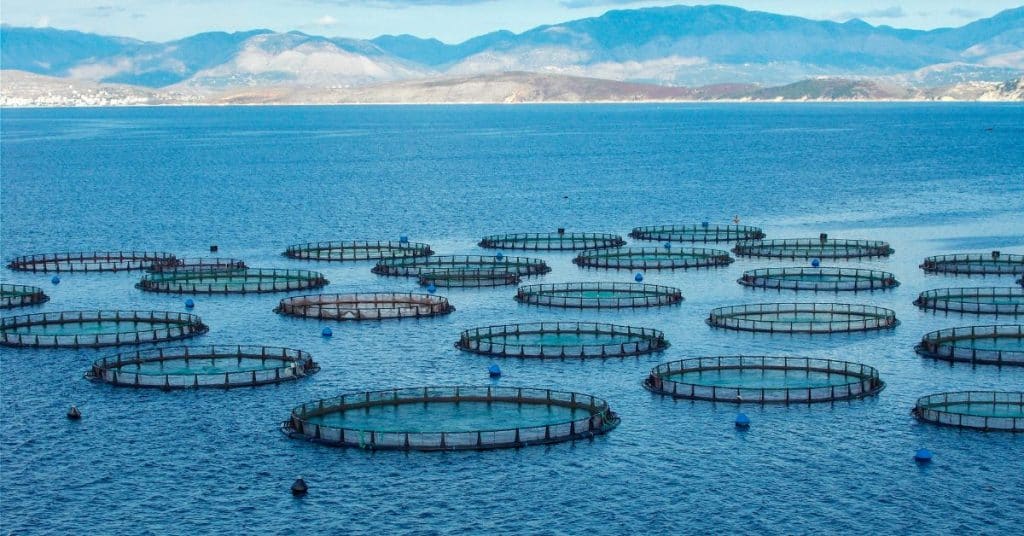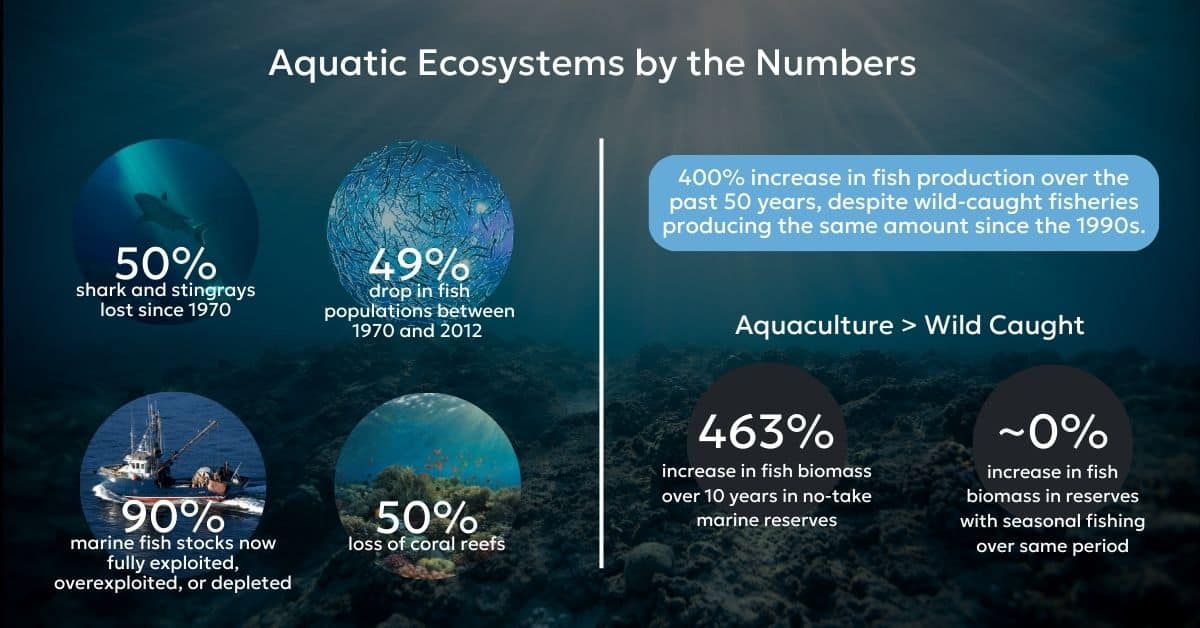

Aquatic ecosystems worldwide are facing severe challenges according to nearly every available metric. Recent reports indicate that shark and stingray populations have been halved since 1970, trends which echo earlier studies showing a 49% decline in fish populations between 1970 and 2012.[1][2] Today, nearly 90% of global marine fish stocks are fully exploited, overexploited, or depleted.[3] In addition, one-third of all marine mammals and reef-forming corals are threatened with extinction globally while more than half of coral reefs have been lost due to climate change.[4][5]
These dramatic declines have strained the global fishing industry, even though it is the primary contributor to the problem. Despite improvements in fishing methods, the number of wild-caught fish has plateaued since the early 1990s, even as global fish production has quadrupled over the past 50 years.[6] To compensate for the ongoing collapse of aquatic ecosystems, aquaculture has become dominant, with more global fish consumption now coming from fish farming than wild-caught sources. Aquaculture is the fastest-growing sector of the food system, valued at USD 160.9 billion in 2024 and projected to grow to USD 262.09 billion by 2032.[7]
While many in the fishing and seafood industry see the rise of aquaculture as a sustainable solution, scientists and health experts are sounding alarms about the dangers it poses to both personal and environmental health.

Unlike land-based operations, the fishing and aquaculture industries mostly take place away from scrutiny, contributing to a lack of public awareness about their impacts. However, the health of our oceans, which cover 71% of the Earth, cannot be separated from the overall health of the planet.
Aquaculture shares many of the same problems as industrialized terrestrial livestock production. Much like concentrated animal feeding operations (CAFOs) on land, fish farms require high feed conversion ratios and intensive inputs, and they often operate in concentrated environments that demand significant ecosystem alterations. There are over 150 types of fish farmed in aquaculture, with feed conversion ratios ranging from 1 to 2.4.[8] Salmon farming, in particular, has grown significantly, with over 70% of salmon now produced in aquaculture, a process that requires a feed conversion ratio of 1.2.[9] The use of smaller fish to feed these farmed salmon has had a substantial impact on the broader aquatic food chain, depleting vital food sources for wild fish.
Additionally, aquaculture is the leading driver of mangrove loss worldwide. Shrimp production alone is responsible for 38% of global mangrove loss.[10] Mangroves provide crucial habitat and spawning grounds for fish and serve as natural barriers that protect coastal areas from storms. Scientists estimate that mangroves prevent approximately $855 billion in annual damages to the global economy from hurricanes, tropical storms, and flooding.[11] Moreover, mangrove forests are vital carbon sinks, playing an essential role in climate change mitigation.
Aquaculture, along with terrestrial agriculture, also contributes significantly to the growth of hypoxic dead zones—areas where oxygen levels are so low that most complex life cannot survive. In the 1960s, there were around 50 identified dead zones. Today, due to nutrient pollution, there are more than 700 such zones around the world. The largest dead zone, spanning 6,334 square miles, is located in the Gulf of Mexico, fed by agricultural runoff from the Mississippi River.[12]
Beyond these issues, aquaculture systems involve and produce numerous other challenges, including antibiotic overuse, disease outbreaks affecting wild populations, unsanitary treatments for lice and other pests, and rampant animal abuse. The problems facing our oceans are vast, but they are not inevitable. They are purely the result of human actions—particularly our insatiable demand for seafood. However, oceanic ecosystems have shown remarkable resilience when given the chance to recover.[13] If we reduce our seafood consumption, we could allow the oceans to rebound naturally without the active stewardship needed for land-based ecosystems. We just have to get out of the way.
Copyright 2025 Center for Nutrition Studies. All rights reserved.